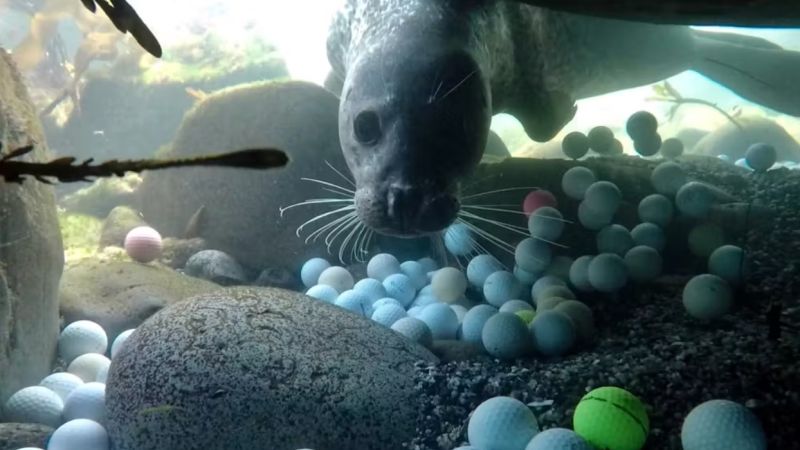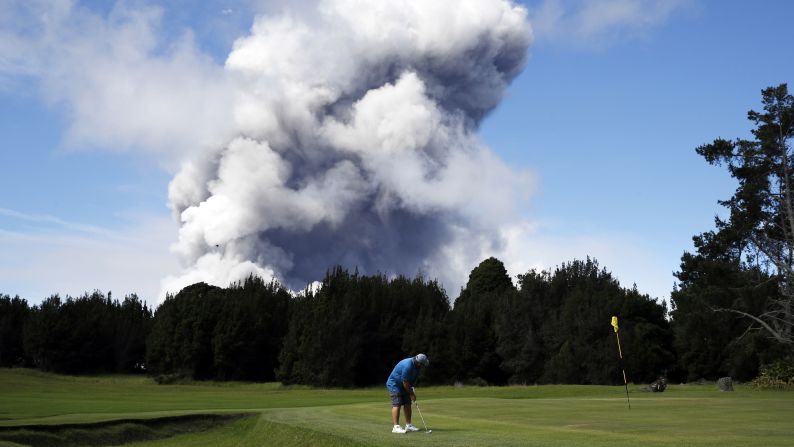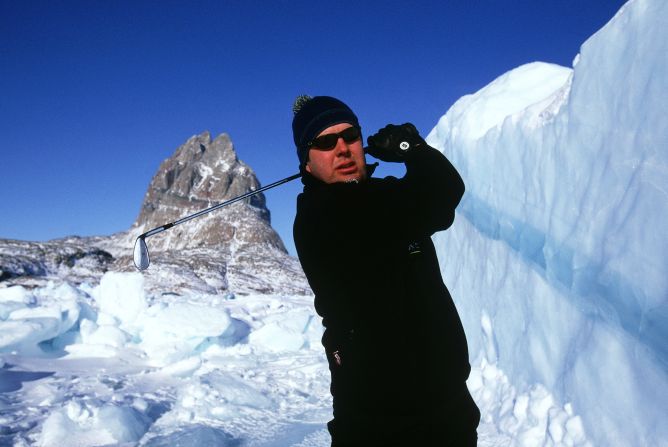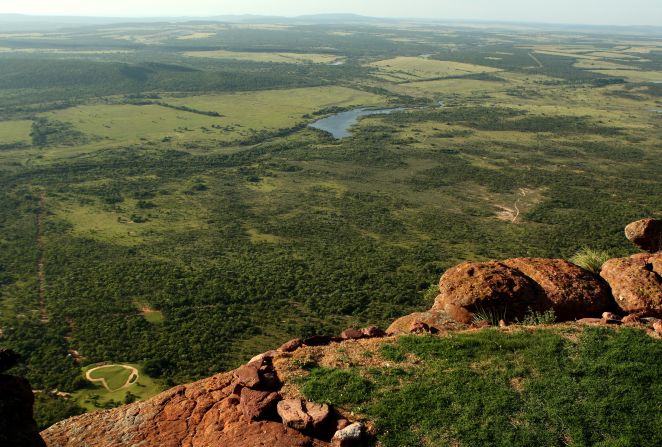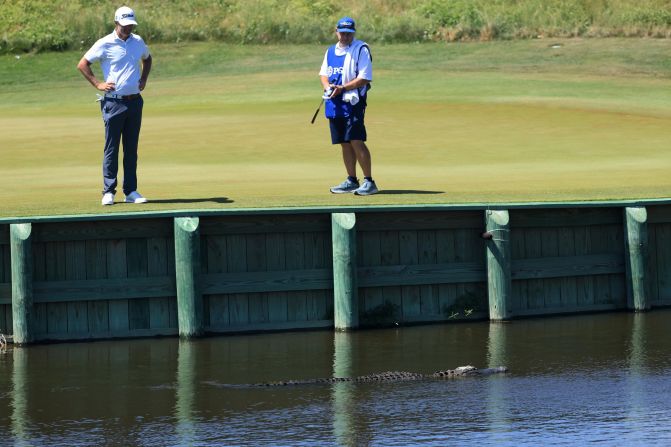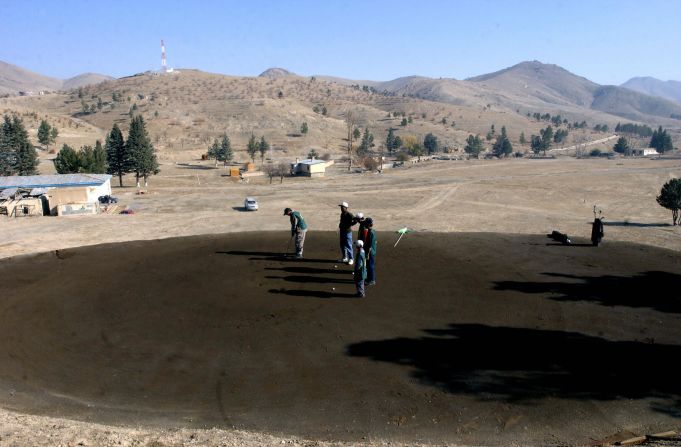CNN
—
Tiger Woods scrunches his face in frustration as he watches his ball splash into the Pacific Ocean.
The momentary aberration is little more than a footnote to what will be regarded by many as the greatest performance in the history of the sport. Woods’ staggering 15-shot victory at the 2000 US Open in Pebble Beach, California, showed a level of a mastery that may never be matched.
And yet, Woods lost a ball. His hooked shot from the 18th tee sank some 40 feet to join the other white, pink and yellow orbs scattered across the sea floor of Stillwater Cove.
If the world No.1 and future 82-time PGA Tour winner could surrender a ball to the environment at the peak of his near-superhuman powers, just how many do the millions of mere mortal golfers across the globe lose each year?
The short answer: A lot.

Heavy losses
A record 45 million people played the sport in the US during 2023, according to the United States Golf Association (USGA), and there were another 31.6 million unregistered and registered golfers across 146 countries last year, according to the R&A.
In 2019 the US boasted 43% of the world’s golf courses with 16,752, the R&A reported. That’s more courses than the number of Starbucks or McDonalds stores across the country and the stage for a record 531 million rounds of golf nationwide in 2023, according to the National Golf Foundation (NGF).
As any amateur who has picked up a club will know, the chances of finishing a round with the ball you started with are slim. While a myriad of factors can affect those odds – chiefly, skill and the topography of the course – estimates for the number of balls lost by the average golfer per round typically vary between one and four.
Found Golf Balls CEO Shaun Shienfield, whose company recovers and resells millions of lost balls across the US and Canada each year, told CNN that he gauged the average to be between three and four each round.
Using Shienfield’s low estimate, that’s over 1.5 billion balls lost in the US every year since 2020. If those balls were laid in a row, they would extend around the Earth’s circumference more than one and a half times.
Add in the rest of the planet’s golfers and the number of lost balls could be much higher, according to Torben Kastrup Petersen, course manager for Danish Golf Union, which has researched the environmental impact of lost balls.
“While precise global estimates are challenging … the worldwide figure could easily exceed 3 to 5 billion golf balls lost each year,” Petersen told CNN.
With courses present in 84% of the world’s countries, there are few environments that have not become unintended lodgings for a golfer’s errant shot. Tee drives have been struck everywhere from the icy plains of Greenland to the billowing rims of Hawaiian volcanoes, and from the peaks of South African mountains 4,500 feet above sea level to beside the whale-filled waters of Norwegian fjords.
It doesn’t take a course to lose a ball either. In 2009, US scientists searching for evidence of the Loch Ness monster via submarine were stunned to make an entirely different discovery lurking amid the depths – tens of thousands of golf balls.
It was thought that locals and tourists had been using the Scottish lake as an alternative driving range for years. Submerged in silt some 750 feet down on the inky black bed of the loch, the balls were beyond hope of retrieval without extensive equipment and expense.
The world’s most extreme golf courses
Water hazards
A lifelong lover of all things marine, conservation biologist Matthew Savoca had been closing in on his PhD in ecology at the University of California, Davis, when, in 2017, he received a detailed scientific enquiry from an unlikely source – a high schooler.
Alex Weber, a junior at Carmel High School, asked Savoca, the author of various papers on the impact of plastic pollution on ocean wildlife, for his advice regarding what she’d found snorkeling in Monterey Bay National Marine Sanctuary near Pebble Beach.
Curiosity piqued, Savoca was blown away when Weber lifted the doors on her parents’ garage to present her loot: barrel upon barrel overflowing with golf balls.
By that point, in early 2017, Weber and friend Jack Johnston had collected around 10,000 balls. Over the next year and a half, the duo recruited friends and family to pluck almost 30,000 more from the shoreline and shallow waters off Pebble Beach and nearby coastal courses Cypress Point and Carmel River Mouth.

Some employees from the world-renowned Pebble Beach course joined the effort, Savoca recalled, adding roughly 10,000 balls to take the total haul to 50,681 or, as Savoca puts it, a “startling” 2.56 tons of plastic debris – the weight of a small pickup truck.
The findings were compiled in a peer-reviewed joint paper that the team hoped would serve as a blueprint for tackling the issue on a mass scale. Savoca estimated that at Pebble beach alone, as many as 186,000 balls – or 9.42 tons of debris – end up in the waters each year.
“If we want this issue to be mitigated, to be dealt with, what we need is a blueprint – where the pollution is, how much pollution is out there, what are the collection methods that work and what are the consequences if we don’t do collections?” Savoca told CNN.
“It’s there forever”
Those consequences, Savoca says, could be dire for the harbor seals and endangered California sea otters that Weber watched playing among the swell of golf balls, as well as countless other species – humans included.
Modern golf balls are typically composed of a synthetic rubber (polybutadiene) core encased within a synthetic polymer (urethane elastomer) cover.
Manufacturers, Savoca explained, add zinc oxide, zinc acrylate and benzoyl peroxide to cores to boost flexibility and durability – substances “acutely toxic” to marine life. Intact, the balls pose little threat, but as they slowly disintegrate on the seafloor, these chemicals join tiny plastic particles seeping out into the ocean. These particles “just get smaller and smaller until they eventually get in the food web and eventually get into us,” Savoca explained.
“Once they (golf balls) become those microscopic-type fragments, there’s basically no cleaning it – it’s there forever,” he added.
“But you have an opportunity, when the materials are big enough to actually retrieve them, to prevent a type of pollution that’s impossible to deal with later – decades or even centuries from now.”

Savoca estimated that roughly 28 kilograms (61.7 pounds) of irrecoverable debris had been lost to the sea from the balls they retrieved near Pebble Beach alone. The popularity of coastal golf courses worldwide means that globally, that number will be much higher.
Mitchell Schols, founder of Canada-based Biodegradable Golf Balls, put a “very conservative” estimate for North America at one million balls lost to oceans annually. He estimated another 100,000 balls are lost to the sea each year in each of the next five biggest golf markets: Japan, South Korea, England, Germany and Australia.
Consider that coastal golf courses are themselves vastly outnumbered by those located inland, and the implications of billions of balls bouncing into the environment are almost too much for Savoca to compute.
“Just in America, you’re talking about tens of thousands of tons of this debris, every year,” Savoca said. “It’s really hard to wrap your mind around.”
Savoca’s discoveries built on 2009 testing by the Danish Golf Union, which found golf balls release a high quantity of heavy metals when decomposing, with dangerous levels of zinc discovered in the synthetic rubber filling used in solid core balls.
The researchers also concluded that it takes between 100 and 1,000 years for a golf ball to decompose naturally. Course manager Petersen stresses the need for “industry-wide solutions.”
“Addressing this problem is not just about managing waste but also about mitigating broader ecological impacts,” Petersen said.
“Golfers need to be made more aware of the environmental impact of lost balls,” he added.

Bio-balls
Potential solutions have surfaced in recent years.
Spotting a gap in the market, Schols launched Biodegradable Golf Balls to offer an eco-friendly “guilt-free” alternative for golfers playing around – and even on – the water.
They are made with a water-activated biodegrading compound that means the balls dissolve within four weeks of contact with water, releasing non-toxic corn starch and polyvinyl alcohol (PVA), a water-soluble synthetic polymer, which similarly disintegrates. If left on land, the balls could take between one and two years to biodegrade, Schols added.
The company’s target market includes coastal resorts and events, boat owners and cruise ships, but not the average golfer. The lack of a rubber core contributes to a roughly 30% distance loss compared to the typical ball, Schols explained, meaning the balls are best suited to usage such as hitting targets near or into water.

It is a similar story for Albus Golf, a Spanish golf ball manufacturer that designed the Ecobioball and Ecocoralball, which dissolve upon contact with water to release fish food and coral food respectively within 48 hours. Their “single-use” lifespan and performance drop-off severely limits their uptake among regular players.
Schols is surprised that larger companies have not yet put a high-performance biodegradable “green-use” ball to market. Currently working on a version of his own, he is optimistic that big names will soon follow suit.
“It’s only a matter of time before we see a lot of these bigger golf companies jump in and start putting the sustainability aspect of their business in the forefront of the consumer,” Schols said.
Cleaning up
Until then, the best solution may be the most obvious one, a five-word mantra that Savoca believes would go a long way to solving all manner of pollution: “Just clean up after yourself.”
Many do. As Found Golf Balls’ entire business model attests to, lost does not necessarily mean unfindable. CEO Shienfield estimates that in the US 150 million balls a year are recovered from the environment and recycled through companies such as his own.
By the USGA and R&A’s definition, a ball is deemed “lost” if it cannot be found within three minutes of the golfer or caddie beginning to search for it. That leaves a wide window for many to be retrieved at a later date, be it by a player, club staff, or even a good citizen – one man and his dog collected over 6,000 during a five-year effort in London.
A global retrieval industry represents a potentially substantial alleviation in the pile up of lost balls. One UK-based man told CNN in 2015 that he could earn up to £100,000 (about $114,000) annually by diving to retrieve golf balls from lakes on golf courses. A 12-strong set of 2023 Titleist Pro V1 balls in near mint condition (minor markings or surface scratches) currently resells for $23.99 on the Found Golf Balls website.
Some manufacturers are also making efforts to retrieve balls. According to Titleist’s website, its subsidiary PG Golf has recovered and resold over 39,000 tons of used golf balls since it was founded in 1992, recycling upwards of 40 million balls each year from courses across 43 states to put rubber, surlyn and urethane products “back into play.”
Many courses operate their own in-house retrieval systems. TPC Sawgrass, for example, hires professional divers to help reclaim some of the estimated 120,000 balls that annually splash into the waters surrounding the Florida course’s legendary par-three 17th hole island green.

Pebble Beach began a golf ball recovery program “in earnest” in 2017, a spokesperson for Pebble Beach Resorts told CNN. It regularly collaborates with professional divers to retrieve balls from the sea, as well as collecting balls from shoreline and beach areas, supplemented by communicating rules prohibiting golfers from intentionally hitting into the ocean.
“Our collection efforts are part of a comprehensive program to be great environmental stewards across the entire resort, both on and off the golf course,” the spokesperson added.
“Pebble Beach Resorts is situated on one of the most spectacular backdrops not only in golf, but the world over and we are committed to preserving the beauty and health of our natural environment for generations to come.”
Such efforts serve to chip away at the growing number of lost balls – just how much of a dent they make, Savoca asserts, comes down to a matter of willingness.
“I’m not here to say golf shouldn’t exist or people shouldn’t play golf,” he said, “but just try to do your best to clean up.”


